Shortage hits schools as transition policy takes effect

Teachers Service Commission chairperson Lydia Nzomo addressing journalists at the agency's offices in Nairobi on January 2, 2019. The TSC wants more teachers employed to ease shortage. PHOTO | FILE | NATION MEDIA GROUP
What you need to know:
- The new curriculum is expected to increase further the teacher requirement because of the anticipated reduction in the class size and inclusion of new competence areas.
- The government will need to recruit 12,626 teachers per year for the four years starting 2018 to cushion schools against the transition challenges.
Bungoma, Kisii and Makueni are among the counties worst hit by a serious secondary schools teacher shortage as the 100 percent transition policy takes effect, it has emerged.
A new report by the Teachers Service Commission (TSC), seen Nation, reveals that secondary schools are reeling from a massive shortage of tutors, putting a major strain on the small number of staff handling the many students arising from the transition programme initiated last year.
The report titled, National Staffing Position in Post Primary Schools, and which gives figures as at November last year, reveals that secondary schools across the country have a shortfall of about 57,380 teachers.
The TSC says at the time the country required at least 136,989 teachers, but only 77,609 were on duty, serving about 2.5 million students in the 8,441 secondary schools across the country.
And Bungoma, Kisii, Makueni, Machakos and Kitui were revealed to have been the five worst hit counties by the teacher crisis at the time, meaning the shortage could be much higher after this year’s Form One intake reported last month.
SHORTAGE
The report, for instance, points out that out of the 6,170 teachers required in Bungoma, the county has a total of 3,338 teachers, meaning TSC is required to recruit some 2,832 tutors to bridge the gap.
Kisii, which has about 3,845 teachers, has a shortfall of 2,589 teachers to enable it reach its required number of 6,434 teachers.
Makueni, on the other hand, requires 2,579 teachers. The county currently has 2,825 teachers.
Other counties that have been hardest hit include Bomet (2,133), Busia (1,495), Homa Bay (2,270), Kakamega (2,991), Kitui (2,323), Meru (2,240), Migori (2,122) and Nakuru (2,580).
The revelations come as the TSC prepares to recruit 5,000 teachers this month.
This is part of its measures to ease the burden on the staff who are handling nearly two million students who joined public schools in 2018 and 2019 under the 100 per cent transition programme.
FUNDS
According to a document prepared by TSC chief executive Nancy Macharia, the government will need to recruit 12,626 teachers per year for the four years starting 2018 to cushion schools against the transition challenges.
The programme has led to the establishment of additional classes within existing schools to cater for increased enrolment. A class will consist of a maximum of 50 learners.
In the document, ‘Proposal on Teacher Requirement for the Implementation of 100% Transition of Learners from Primary to Secondary School (2018-2022)', Dr Macharia said TSC would still continue replacing teachers who leave service in natural attrition.
If the government is to strictly yield to the TSC request for recruitment of 12,626 staff annually for five years to handle the transition pressure, the Treasury will provide Sh8.33 billion per year for the plan, according to the document.
SYLLABUS
Further, Dr Macharia said the Implementation of the Competency-Based Curriculum is expected to increase further the teacher requirement because of the anticipated reduction in the class size and inclusion of new competence areas.
At the primary school level, the commission is faced with a teacher shortage of 30,000 teachers and 1,248 at tertiary institution level.
So bad is the situation that the commission recently made a proposal to be allowed to procure services of relief teachers at subsidised salaries to help ease the teacher shortage.
Under this plan, the TSC will draw the temporary staff from those registered but unemployed.
Before the requirement for teachers to handle the transition cohorts, the commission had consistently requested for increased budgetary provisions to employ 20,000 teachers annually to deal with the staff shortages.






